Top News
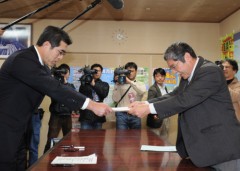
February 8, 2012 Ryukyu Shimpo
The Okinawa Prefectural Board of Review has completed its review of the environmental impact assessment report (EIA) on the alternative facility construction plan for the relocation of U.S. Marine Corps Air Station Futenma to Henoko, Nago. On February 8, Kuniharu Miyagi, professor at Okinawa International University and chairman of the Board, reported to Hiroshi Shimoji, head of the Okinawa Prefectural Government Department of Environmental and Community Affairs at the Okinawa Prefectural Government (OPG) Office. Miyagi pointed out that large-scale reclamation, construction and ongoing use of the military air base could have an immeasurable impact on the surrounding natural environment, stating, “It is impossible that the environmental protection policy and other measures suggested in the EIA could conserve the living environment and natural environment around the area where the project is to be carried out.” The Board in effect rejected the current relocation plan.
The Board criticized the Okinawa Defense Bureau officials for delivering the EIA to the OPG Office before dawn at the end of last year and the plan to deploy MV-22 Osprey vertical takeoff and landing transport aircraft being included for the first time in the evaluation report at the final stage of the assessment process. Miyagi said, “The measures suggested in the EIA regarding conservation of the natural environment such as coastal water body and prevention of noise generated by aircraft are not appropriate for this kind of project.” Governor Hirokazu Nakaima is required to submit a written statement of opinion to the Okinawa Defense Bureau by February 20.
(English translation by T&CT, Mark Ealey)
Go To Japanese
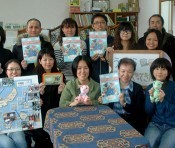
February 5, 2012 Ryukyu Shimpo
The Okinawa NGO Center, which conducted the “Let’s Study! The Worldwide Uchinanchu Project,” in which during the 5th Worldwide Uchinanchu Festival students in Okinawa learned about the history of Okinawan migrants, published CHAMPURREADO, a booklet containing the educational materials used in the project. The Center plans to distribute these booklets to schools and libraries in Okinawa and to call for the continuation of such studies.
From February to December 2011, the Center implemented the project for about 16000 students of elementary schools, junior high schools and high schools, and special-needs schools within Okinawa. The materials in the booklet introduces not only the experiences of Okinawans who emigrated but also nostalgic reflections on the lyrics of Choki Fukuhara’s Imin Ko-uta (Migrant Song), a song about the feelings of Okinawans who migrated to Hawaii for economic reasons. The booklet includes detachable photographs and cards, which enable pupils to actively learn about Okinawan migrants and their societies in an enjoyable manner.
Satsuki Kinjo, a staff member of the Center, said, “Some of the students did not know about Okinawan migration and the reason behind the Worldwide Uchinanchu Festival, but our project made them aware of this. Even after the Festival was over, we would like them to continuing these studies.”
Many people in Okinawa, including high school teachers, were involved in creating the booklet. One of them is second generation Okinawan Argentinian Patricia Matayoshi, who said, “Although I was proud of being of Okinawan descent, at first I thought that it was a little bit of a shame that so few people knew that Okinawans had emigrated overseas to countries such as Argentina. I am glad that young people in Okinawa can use these materials and learn about Okinawan migrants.”
The booklet is not sold in bookstores.
For further details, call the Okinawa NGO Center at 098 (892) 4758
(English translation by T&CT, Mark Ealey)
Go To Japanese
February 2, 2012 Ryukyu Shimpo
On February 1, professional baseball spring training camps started in Okinawa and Miyazaki prefectures. Twelve baseball teams train throughout the month, aiming to improve prepare for games on March 30, the day that both the Central League and the Pacific League commence.
In Okinawa, nine teams began their training. The Chunichi Dragons which aims its third consecutive victory in the leagues (Chatan), a new baseball team the Yokohama DeNA Baystars (Ginowan), the Hanshin Tigers (Ginoza) and the Hokkaido Nippon-Ham Fighters (Nago), each team met their new managers and made a start to the season. Players from Okinawa, Shota Ishimine of the Chiba Lotte Marines (Ishigaki) and Wataru Hiyane of the Tokyo Yakult Swallows (Urasoe) started in their respective team’s first team camp.
At each baseball park, many visitors watched for players practicing. Before the Hiroshima Toyo Carp (Okinawa) started training, the FC Ryukyu of Japan Football League wished them well. The Tohoku Rakuten Golden Eagles (Kumejima) did their early-morning workout from 7:00am. At the training of the Orix Buffaloes (Miyakojima), Lee Dae-Ho, the former Triple Crown winner attracted a great deal of attention.
(English translation by T&CT, Lima Tokumori and Mark Ealey)
Go To Japanese

Go To Video
February 1, 2012, Ryukyu Shimpo
On January 31 the Marines Corps revealed that in addition to Futenma Air Station, they plan to operate MV-22 Osprey vertical takeoff and landing transport aircraft in the U.S. Central Training Area, which includes Camp Hansen and Camp Schwab, the Northern Training Area and Ie Jima Auxiliary Airfield. They also indicated that Osprey would land at Kadena Air Base in cases of emergency. This is the first time that the Marine Corps has revealed the details of military facilities that would host the Osprey and this statement confirms that these aircraft would be deployed extensively in U.S. military bases in Okinawa.
When interviewed by the Ryukyu Shimpo that same day, a spokesman for Marine Corps Consolidated Public Affairs Office in Okinawa revealed the details of the environmental evaluation carried out in conjunction with the deployment of the Osprey in Okinawa. In addition to at Futenma Air Station, they have been carrying out environmental evaluations on Marine bases to which Osprey would probably be deployed and have given the specific names of these facilities.
The Marine Corps has initiated environmental evaluation reports and noise-related surveys within Okinawa and plans to complete the noise-related surveys by the end of February. They aim to complete the environmental evaluations, which include the results of the noise-related surveys, at the end of April. Among the items in the evaluations, they mentioned air stations and air space, land utilization, biological resources and cultural assets.
Although the Marine Corps stated that if they found significant negative impact in the environmental evaluation process they will report it to the country that hosts the U.S. military facilities, which of course in this case is Japan, they are unlikely to report any results in the evaluation that they do not judge as not having “significant impact.” While they confirm that 24 aircraft will be deployed, they state that they have not made the final decision on the schedule for deployment.
(English translation by T&CT, Mark Ealey)
Go To Japanese
January 31, 2012 Ryukyu Shimpo
Continuing on from the pilot program shipping less-than-container load cargos to Hong Kong that has been running since November, the Naha Port Authority will start such exports to Taiwan from February. There is no direct route from Naha to Taiwan, but some local companies in Okinawa have strongly requested such a freight service. The Naha Port Authority hopes to respond to this need through the pilot program and to help expand exports in the future by considering the introduction of a regular freight service. Exports to Hong Kong also will be continued.
In the pilot program of exports to Taiwan, cargo will be carried from Naha Port to Keelung Port in Taiwan via Shanghai on the regular service for shipping marine containers. The first ship will depart from Naha Port on February 10 and arrive at Keelung Port on February 21. The service is scheduled to see ships depart on the second and fourth Friday until some time around March. Shipping cost is calculated per cubic meter and the Naha Port Authority will pay the freight cost.
The pilot program is a part of a business model project out of Naha Port. Because of the desire to support the expansion of exports of Okinawan products from the logistics angle, this project seeks to establish the cost and freight time and to look at measures to enable full introduction. In the pilot program of exports to Hong Kong started from November, processed goods made in Okinawa such as cosmetics, salt and brown sugar have been transported.
The Naha Port Authority is seeking exporters to participate in the pilot program. The deadline for the first ship is February 7. From 3:00pm on February 2, a briefing session will be held for exporters. For further information contact the Naha Port Authority. Telephone: 098 (868) 4544
(English translation by T&CT, Lima Tokumori and Mark Ealey)
Go To Japanese
February 5, 2012
The governments of Japan and the United States have commenced consultation on the proposed revised plan in which the U.S. Department of Defense has suggested distributing some of the approximately 8000 U.S. Marines who were originally down to move from Okinawa to Guam to locations in the Asia-Pacific region, such as Hawaii. This Guam relocation plan for the Marines stationed in Okinawa is the basis of the Agreement on the Realignment of U.S. Forces in Japan between Japan and the United States reached in 2006, along with the conditional return of Futenma Air Station and relocation to an alternative facility to Henoko in Nago. Because their thought processes seem to have stopped on the issue of relocating to Henoko, resumption of talks on this would effectively be a step towards stalemate. The most important thing for Okinawans is the direction of the proposed revision of the realignment – whether it is towards the best or worst scenario for the people of Okinawa. We want to avoid potential worst case scenarios, such as these three points becoming part of the revision plan to realign U.S. forces: a) the facilities in question staying put at Futenma Air Station, b) the Henoko relocation plan remaining as is, c) the freezing of plans to return land of south of Kadena. This would be absolutely unacceptable to us.
We want to eliminate the risks posed by Futenma Air Station – which U.S. officials have described as “the most dangerous air base in the world” – as soon as possible. To avoid accidents, we want to reject the deployment of the MV-22 Osprey vertical takeoff and landing transport aircraft in Okinawa because it has been described as having inherent defects. These standpoints represent the views held by the vast majority of the Okinawan public. If the governments of Japan and the United States place a high priority on human rights or human life, and would like to normalize relations between Japan and United States supported by the trust of the Okinawan people, the best course of action would be the unconditional return of Futenma Air Station to the Okinawan people or to relocate those facilities either outside the prefecture or abroad.
According to the U.S. media, the Obama administration is planning to move 4500 Marines from Okinawa to Guam, with another 4000 being rotated to Australia, the Philippines and Hawaii. This policy change is premised upon the Henoko relocation plan being implemented. On February 3, Foreign Minister Koichiro Genba clearly stated, “There is no change in the thinking that relocating the facilities at Futenma to Henoko is the best course of action, and that approximately 10000 Marines will remain in Okinawa.”
If both governments continue to move in this direction, in addition to the facilities at Futenma Air Station staying where they are, the issue of relocation to Henoko could be just pushed onto the back burner, neither abandoned nor advanced.
To safeguard its national interests, the United States Government aims to redeploy the Marine Corps to match its new Asia-Pacific strategy. Nearly 4500 members of the Marine Corps will be transferred to Guam from Okinawa, with another 4000 being rotated to different locations, but maintaining the option to come back here at any time. Furthermore, both governments are reconsidering the plan to return land used by the U.S. military in the area south of Kadena being included in the realignment of U.S. forces. We speculate that they intend to preserve that space to accommodate 10000 Marines. Such a development would be a nightmare for the Okinawan people.
The Japanese government must not simply repeat the foolhardy practice of following meekly behind the United States and forgetting about the citizens of Okinawa. The people of Okinawa must also seek to calmly identify the intent behind the policies of both governments and patiently continue our demands for the base issue to be resolved.
(English translation by T&CT, Mark Ealey)
Go To Japanese
January 31, 2012 Ryukyu Shimpo
On January 30, the Okinawa Prefectural Government (OPG) revealed an outline of a new division designed to gather information and carry out research on security issues from April. The OPG is planning to commission specialists in Japan and the United States to gather information and offer opinion on topics such as security issues, and based on the advice and opinion received, the OPG will then conduct its own research from the Okinawan perspective. It is unusual for a regional government to establish a domestic and international professional network for the purpose of researching security issues, something that the central government has exclusive jurisdiction over. The new division will comprise one researcher from outside of Okinawa, and about five OPG staff members.
The OPG will ask five or six specialists in Japan and the United States to gather information and offer opinion. Intellectuals from the Okinawa Question U.S.-Japan Action Committee, which conducted debates on U.S. military issues and security policies, will be the central U.S. specialist members.
Five or six specialists will make up the core of the group, but, depending on the topic, the OPG will also request opinion from other relevant experts. The number of specialists to be called upon is yet to be determined.
Last year during his visit to the United States, Governor Hirokazu Nakaima attended the international symposium entitled the “Okinawa Question” and for the first time made a direct appeal in the United States for Futenma Air Station to be relocated outside of Okinawa Prefecture. The head of the Executive Office of the Governor, Susumu Matayoshi, also visited the United States on a fact-finding mission indicating that the OPG is taking steps to utilize the network it has created in the United States.
Governor Nakaima has alluded to the concept of establishing a research institution to look at general security issues, starting this off from the new division’s activities within the Prefectural Government. According to the OPG, this division could eventually develop into an independent research institution.
Issues of the Japan-U.S. Status-of-Forces Agreement, the reality behind the presence of the U.S. Marine Corps in Okinawa, which the Japanese and U.S. governments both describe as “deterrence,” and China’s maritime expansion will be the main research themes.
An executive member of the OPG explained the role of the new department, stating, “The prefecture is influenced by a range of security related issues. We, as a prefectural government will consider the impact on Okinawa of the current security situation.” In addition, with regard to the request to relocate the facilities at U.S. Futenma Air Station out of Okinawa, the OPG emphasized, “To avoid the situation in which we are obliged to accept that the U.S. military will always be in Okinawa, we need to gather more information and arm ourselves with all the knowledge we can.”
The OPG had planned to set up a base for information gathering in the United States in April, but it was postponed within the 2012 fiscal year. With the establishment of the new division, the OPG is also considering combining and abolishing other divisions in its Executive Office.
(English translation by T&CT, Megumi Chibana and Mark Ealey)
Go To Japanese
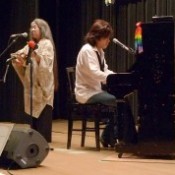
January 30, 2012 Ryukyu Shimpo
On January 29, a concert using a piano that was damaged by the atomic bombing of Hiroshima was held at the Okinawa Prefectural Peace Memorial Museum in Itoman. Michihiko Ota, who lives mainly in Okinawa and the Kanto region, and several other musicians performed. Okinawan singer Misako Koja, and Kajimai a drum and kobudo (traditional martial arts) group awarded a grand prize in the World Eisa Festival 2011, also appeared as guest performers. The piano’s resounding sound lingered in the site of some of the bloodiest combat in the Battle of Okinawa.
Fifty-nine year-old Hiroshima piano technician Mitsunori Yagawa acquired the pianos from survivors of the atomic bombings and restored them. Now he maintains the pianos and uses them in performances across the country. This is the second concert held in Okinawa since 2007.
He has four such pianos and the one used in the concert was located 1.8 kilometers from the epicenter at the time of the explosion on August 6, 1945. That is the shortest distance among the four pianos.
Yagawa said, “We have to work towards the elimination of nuclear weapons or there will be no future for any of us. I want people to consider this by having the opportunity to listen to music played on a piano that survived an atomic bombing.”
(English translation by T&CT, Shinako Oyakawa and Mark Ealey)
Go To Japanese
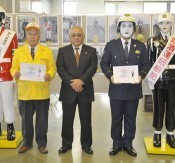
January 29, 2012
On January 27, at Miyakojima and Tarama, the policeman-style figurine Miyakojima Mamoru-kun who always bears up well in all weather conditions and acts as a lookout for society, and his sister Maruko-chan were registered as special residents of Miyakojima.
A ceremony to issue their resident cards was held at the Hirara Government Office Building in Miyakojima City Hall. A real Mamoru-kun, Assistant Police Inspector Kazuhumi Ikema of the Traffic Division in the Miyakojima Police Station stepped in to act as Mamoru-kun, and the Chairman of the Traffic Safety Association in the Miyakojima Area, Toshio Miyazato, submitted the application forms to the Citizens’ Affairs Division of Miyakojima. City Mayor Toshihiko Shimoji duly accepted them and issued the special resident cards.
Mayor Shimoji said, “These two have contributed to eradicating drink-driving and to traffic safety in general. They also call for tourists to drive safely. I hope that they will continue to be popular in the future.” Assistant Police Inspector Ikema said, “I am disappointed that last year the number of recorded cases of drink-driving increased. With that disappointment in mind, and the happiness involved in this registration, I will do my best to reduce the incidence of drink-driving.”
Mamoru-kun is 20 years old and was born on August 5 in 1991. He keeps watch at 19 points on Miyakojima and Tarama. His sister Maruko-chan is 18 years old and was born on March 3 in 1993. She was unveiled last August. Their addresses were registered as the Miyakojima Police Station.
(English translation by T&CT, Lima Tokumori and Mark Ealey)
Go To Japanese
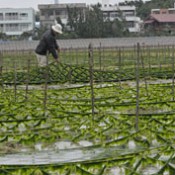
January 29, 2012 Ryukyu Shimpo
At Misaki in Kitanakagusuku, arsa or hitoegusa (Monostroma nitidum Wittrock) seaweed is extending its beautiful green carpet to the beach where seaweed farms are located. In February, it will be the full harvest season for the seaweed, now not far away from being available to eat with fresh seafood. The Okinawa Prefectural Government has certified Kitanakagusuku Village as a site for the seaweed production. On January 27, many people worked hard doing tasks such as adjusting the nets to get ready for harvesting.
Looking at how the seaweed is growing, as he worked, 73 year-old Seisho Tanahara said, “The growth of the arsa is slower than usual because of poor sunshine this year, but its quality is good.”
(English translation by T&CT, Mark Ealey)
Go To Japanese

Go To Video

January 29, 2012 Yuki Nakasone of the Ryukyu Shimpo
A practical research group plans to establish a Shimakutouba or Uchinaguchi immersion school at which children learn Okinawan culture and history through Shimakutouba. The members of the group aim to open the school in April, and they are now developing its curriculum and teaching materials.
Called Okinawan Studies 107, the group is organized by people who have studied in Hawaii, where they were inspired by a movement of native Hawaiians striving to revive aspects of their traditional culture and to reclaim their land.
Immersion schools normally use a language different to the mother tongue of the students as the language for teaching. However, in the proposed Okinawa Immersion School, the teachers will offer Shimakutouba lessons for children before they enter elementary school, through experiential learning, such as nature walks, cooking and playing the sanshin. The target age of the school will be gradually raised.
Shinako Oyakawa, the co-leader responsible for the Okinawan Studies 107 Shimakotouba Division said, “When I had my first child last August, I thought that I needed to work to prepare somewhere that children will be able to learn Shimakutouba.” She went on to say enthusiastically, “Through learning Shimakutouba, I would like our children to sense the connection between themselves and their native land. There are more than 20 immersion schools in Hawaii. At the start of the movement, six mothers worked on it to teach their native language to their children. We can do it too.”
Professor Masahide Ishihara of the University of the Ryukyus, who specializes in language policy, and has been assisting in the establishment of the Immersion School said, “The survival of Shimakutouba is at stake. It is important that people take action to preserve their native language. This school will be a model as the first step in spreading Shimakutouba throughout Okinawa.”
(English translation by T&CT, Mark Ealey)
Go To Japanese








 Webcam(Kokusai Street)
Webcam(Kokusai Street)


